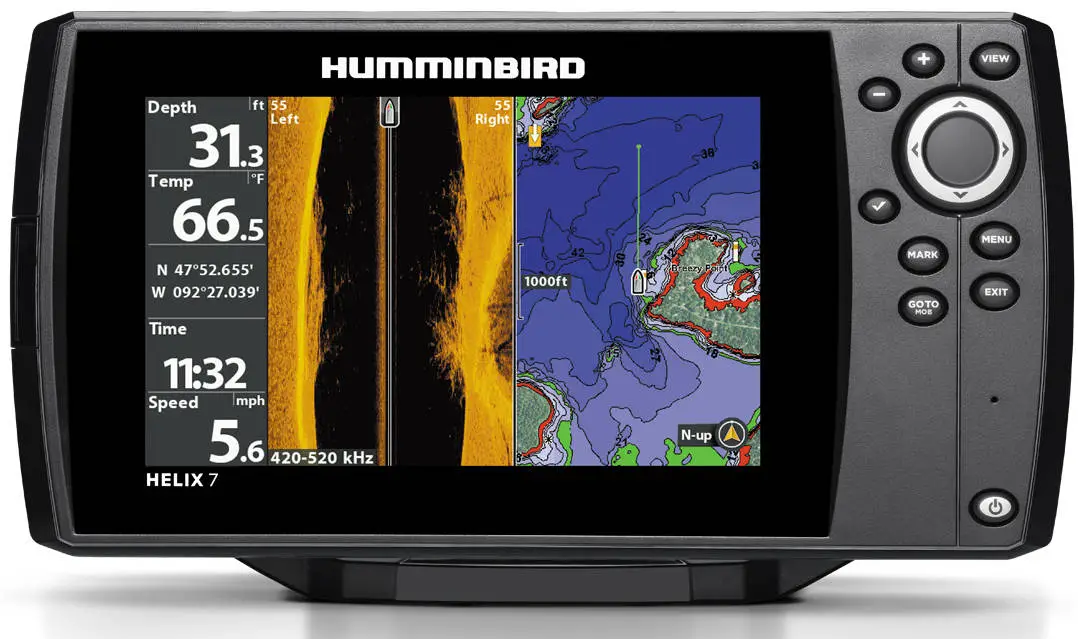What Is The Difference Between Humminbird Helix 5 and Helix 7?
UPDATED 14 MAY 2023
by Robert Ceran
This article may contain affiliate links. If you make a purchase after clicking on a link we may earn a small commission at no extra cost to you.
Are you thinking about getting a new Helix 5 or Helix 7, but aren’t sure what sets them apart, and which model is right for you?
For this article my team and I tested the Humminbird Helix 5 vs 7 fish finder series and compared them side by side. We’ll walk you through our key findings and their most important differences, to help you choose the best model for your purposes.
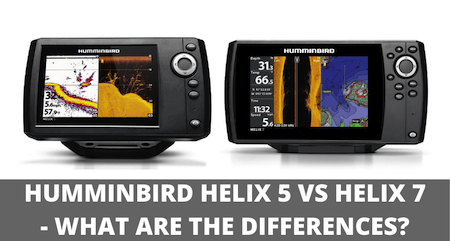
Humminbird Helix 5 and Helix 7 fish finder series compared side by side
The table above compares the most important specifications and features of two models from each series that we tested, to get an overview of their similarities and differences.
Now let’s dive into the details and take a closer look at their most important differences revealed by our testing.
The most important differences between the Humminbird Helix 5 and Helix 7 series
Display size: This is the first area with obvious differences. If you place a Helix 5 unit next to a Helix 7, it’s clear that the latter has a significantly larger screen with 7” diagonal, compared to 5” diagonal of the former.
When we put it to the test, we found that the more generous screen size makes a huge difference if you plan to use split screen functions a lot, and especially on the models with side imaging (SI).
Since side imaging scans large areas at the same time, it really helps to have a larger screen size for this, especially if you plan to run it side by side with down imaging or GPS data on a split screen.
Bottom line: Based on our testing, the larger display size of the Helix 7 is much better for reading sonar signals (especially side imaging data), and for using split screen views effectively when you combine several different functionalities at once.
Mapping: While the low end Helix 5 models don’t have mapping capabilities, high end models as well as all Helix 7 models do.
However, models of the latter series have more advanced mapping functionalities, and come with an integrated base map, and are also compatible with Lakemaster and Navionics maps.
GPS: The low end Helix 5 models don’t have internal GPS, while high end units plus all Helix 7 models do.
CHIRP: Low end Helix 5 models don’t have CHIRP sonar (which generates more detailed and crisp read outs), while higher end models as well as all Helix 7 models do.
Down imaging: All models of both series have down imaging, but some Helix 7 models have mega imaging technology, and our testing revealed that this is of higher quality than the down imaging sonar on Helix 5 models.
Side imaging: High end models in both series have side imaging sonar, while lower end models do not. So this is not a difference between the two series, but rather a difference between high end and low end models in each of the series.
Bottom line: High end Helix 5 models have many of the same features as Helix 7 models, including high quality side imaging sonar, CHIRP sonar, GPS, and mapping functionality.
However, our testing showed that their biggest handicap is the smaller screen size, since the more generous 7” display makes a huge difference in allowing the user to take full advantage of all sonar and mapping capabilities side by side with a split screen view.
Now let’s take a closer look at each of the models in turn.
Helix 5 DI G2
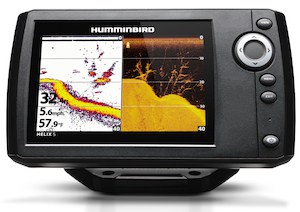

This is an entry level model in this series, and is designed to provide basic 2D sonar and down imaging functionality, but almost nothing else.
It does not have CHIRP, and it doesn’t a GPS receiver, though you can connect it with an external GPS unit, and it also doesn’t have any mapping capabilities.
On the upside, one of the biggest advantages of this unit is the highly affordable price, which makes it a great choice for entry level anglers.
Features:
- Dual beam sonar
- 2.5” target separation
- Temperature sensor
Helix 7 CHIRP Mega DI GPS G4N
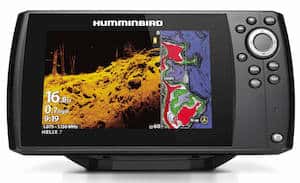

This unit combines high quality down imaging and CHIRP with high end mapping capabilities. This is a perfect choice if you don’t need side imaging, as our testing showed that it provides a set of high end fish finder technologies at a great price.
Among its mapping functionality are chartplotting (creating your own custom maps), as well as full compatibility with Lakemaster and Navionics lake maps.
Features:
- Dual spectrum CHIRP
- Autochart live
- Built in base map
Helix 5 CHIRP SI GPS G2
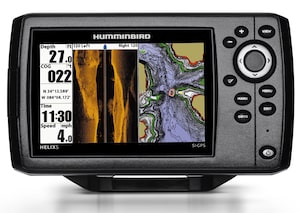

This is a high end model in this series, and comes with CHIRP, side imaging, internal GPS, and some mapping functionalities.
In terms of mapping, it’s compatible with Lakemaster maps, but doesn’t come with a Humminbird basemap. Also, it’s compatible with Navionics gold/hot maps, but not with Navionics Platinum.
Features:
- Dual spectrum CHIRP
- Helix 5 side imaging
- GPS chartplotting
Helix 7 CHIRP MSI GPS G3
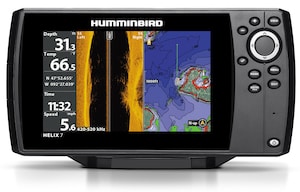

This unit comes with a powerful combination of Humminbird sonar technologies (including CHIRP, down imaging, MEGA side imaging, and dual beam sonar), combined with state of the art mapping capabilities.
Also, when we put it to the test, we found that the generous 7” screen size is perfect for combining several sonar read outs with GPS data on a split screen view, which is much harder to do effectively on the smaller Helix 5 screen.
This unit also comes with ethernet and bluetooth networking capabilities, which is great if you want to work with several devices in parallel.
Features:
- 360 imaging
- Humminbird basemap
- Compatible with Minn Kota trolling motor
What are the different Humminbird Helix 5 models?
Here is a list of the current Humminbird Helix 5 models in 2021:
- Helix 5 CHIRP GPS G3
- Helix 5 CHIRP DI GPS G3
- Helix 5 CHIRP GPS G2
- Helix 5 CHIRP DI GPS G2
- Helix 5 CHIRP SI GPS G2
As you can see, the latest generation of Helix 5 models now automatically come with CHIRP and internal GPS included, and you just need to decide if you want down imaging (DI), or side imaging (SI) in addition to this.
However, not that you can still come across retailers that sell older Helix 5 models without CHIRP or GPS.
If you’re currently debating whether to go for a Garmin unit instead, check out our article on Humminbird Helix vs Garmin Echomap compared.
Helix 5 side imaging
If you want a Helix 5 model with side imaging, you need to look for a Helix 5 SI model specifically, since side imaging is not included automatically in all models of this lineup.
While the quality of the side imaging that you get with a Helix 5 is the same as with a Helix 7, the main caveat to keep in mind is that it’s harder to get the full benefit of side imaging with the small 5″ screen of a Helix 5, rather than the larger 7″ screen of a Helix 7.
If you’re planning to use 360 imaging on your Helix, check out our article covering what Helix models work with Mega 360?
Conclusion
In summary, high end Helix 5 and Helix 7 models have many similar features, including CHIRP sonar, side imaging, GPS, and mapping capabilities.
But when we tested them, we found that the most important advantage of Helix 7 units is their larger screen size, which makes a big difference when you want to combine several sonar read outs with mapping data next to each other on a split screen view.
This size difference between the two lineups is especially significant if you want to use side imaging, because it’s very hard to take full advantage of this type of sonar on a small screen.
However, if you’re not planning to use side imaging, you may not need the larger screen size.
Gear and methods used for testing
For consistent testing results, we tested all fish finder units reviewed above with a XM 9 HW MSI T transducer transom mounted on a Ranger Z520R bass boat. We tested all units on the same day on Lake Tarpon, to make sure we could compare their performance side by side under similar conditions. Testing was performed by imaging schools of bass and panfish that were relating to structure in 6 to 21 feet of water.




